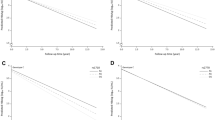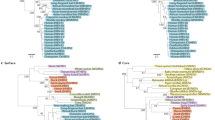Abstract
The polymorphic MHC class I chain-related A (MICA) gene encodes a ligand that has different binding affinities for the NKG2D activating receptor of CD8+ T cells and natural killer (NK) cells. We hypothesized that MICA heterogeneity would affect recovery from hepatitis C virus (HCV) and hepatitis B virus (HBV) infections. To test the hypothesis, we initially typed known MICA polymorphisms for 228 persons who cleared HCV infection and 442 persons with persistent hepatitis C matched on other factors affecting viral persistence. Although MICA*015 was detected more than two-fold more often in persons with viral clearance (odds ratio 0.36, 95% confidence interval=0.19, 0.80), it occurred in fewer than 5% of the study population. In a similar analysis of 442 persons with chronic hepatitis B and 768 matched controls who recovered, MICA*015 was detected in 2.0% of persons with chronic hepatitis B and only 0.9% of controls. No significant associations were detected with other MICA polymorphisms. While further investigation may reveal a structural basis of the MICA*015 associations, these data provide little support for the hypothesis that differential distribution of MICA alleles substantially affects recovery from HCV and HBV infections.
This is a preview of subscription content, access via your institution
Access options
Subscribe to this journal
Receive 6 digital issues and online access to articles
$119.00 per year
only $19.83 per issue
Buy this article
- Purchase on Springer Link
- Instant access to full article PDF
Prices may be subject to local taxes which are calculated during checkout
Similar content being viewed by others
References
World Health Organization. Hepatitis C: global prevalence. Weekly Epidemiol Rec 1997; 72: 341–348.
Kiyosawa K, Sodeyama T, Tanaka E et al. Interrelationship of blood transfusion, non-A, non-B hepatitis and hepatocellular carcinoma: analysis by detection of antibody to hepatitis C virus. Hepatology 1990; 12: 671–675.
Tong MJ, El-Farra NS, Reikes AR, Co RL . Clinical outcomes after transfusion-associated hepatitis C. N Engl J Med 1995; 332: 1463–1466.
Villano SA, Vlahov D, Nelson KE, Cohn S, Thomas DL . Persistence of viremia and the importance of long-term follow-up after acute hepatitis C infection. Hepatology 1999; 29: 908–914.
Kenny-Walsh E . Clinical outcomes after hepatitis C infection from contaminated anti-D immune globulin. Irish Hepatology Research Group. N Engl J Med 1999; 340: 1228–1233.
Muller R . The natural history of hepatitis C: clinical experiences. J Hepatol 1996; 24: 52–54.
Thomas DL, Astemborski J, Rai RM et al. The natural history of hepatitis C virus infection: host, viral, and environmental factors. JAMA 2000; 284: 450–456.
Thio CL, Gao X, Goedert JJ et al. HLA-Cw*04 and hepatitis C virus persistence. J Virol 2002; 76: 4792–4797.
Thursz M, Yallop R, Goldin R, Trepo C, Thomas HC . Influence of MHC class II genotype on outcome of infection with hepatitis C virus. The HENCORE group. Hepatitis C European Network for Cooperative Research. Lancet 1999; 354: 2119–2124.
Thimme R, Oldach D, Chang KM, Steiger C, Ray SC, Chisari FV . Determinants of viral clearance and persistence during acute hepatitis C virus infection. J Exp Med 2001; 194: 1395–1406.
Rehermann B . Interaction between the hepatitis C virus and the immune system. Semin Liver Dis 2000; 20: 127–141.
Tseng CT, Klimpel GR . Binding of the hepatitis C virus envelope protein E2 to CD81 inhibits natural killer cell functions. J Exp Med 2002; 195: 43–49.
Crotta S, Stilla A, Wack A et al. Inhibition of natural killer cells through engagement of CD81 by the major hepatitis C virus envelope protein. J Exp Med 2002; 195: 35–41.
Lee WM . Hepatitis B virus infection. N Engl J Med 1997; 337: 1733–1745.
Yang HI, Lu SN, Liaw YF et al. Hepatitis B antigen and the risk of hepatocellular carcinoma. N Engl J Med 2002; 347: 168–174.
Rehermann B, Fowler P, Sidney J et al. The cytotoxic T lymphocyte response to multiple hepatitis B virus polymerase epitopes during and after acute viral hepatitis. J Exp Med 1995; 181: 1047–1058.
Chisari FV . Cytotoxic T cells and viral hepatitis. J Clin Invest 1997; 99: 1472–1477.
Thursz MR, Kwiatkowski D, Allsopp CEM, Greenwood BM, Thomas HC, Hill AVS . Association between an MHC class II allele and clearance of hepatitis B virus in the Gambia. N Engl J Med 1995; 332: 1065–1069.
Hohler T, Gerken G, Notghi A et al. HLA-DRB1*1301 and *1302 protect against chronic hepatitis B. J Hepatol 1997; 26: 503–507.
Thio CL, Carrington M, O'Brien SJ et al. The association of HLA alleles and clearance of hepatitis B among African Americans. J Infect Dis 1999; 179: 1004–1006.
Almarri A, Batchelor JR . HLA and hepatitis B infection. Lancet 1994; 344: 1194–1195.
Verdon R, Pol S, Landais P et al. Absence of association between HLA antigens and chronicity of viral hepatitis in haemodialyzed patients. J Hepatol 1994; 21: 388–393.
Zavaglia C, Bortolon C, Ferrioli G et al. HLA typing in chronic type B, D and C hepatitis. J Hepatol 1996; 24: 658–665.
Van Hattum J, Schreuder GM, Schalm SW . HLA antigens in patients with various courses after hepatitis B virus infection. Hepatology 1987; 7: 11–14.
Kakimi K, Guidotti LG, Koezuka Y, Chisari FV . Natural killer T cell activation inhibits hepatitis B virus replication in vivo. J Exp Med 2000; 192: 921–930.
Baron JL, Gardiner L, Nishimura S, Shinkai K, Locksley R, Ganem D . Activation of a nonclassical NKT cell subset in a transgenic mouse model of hepatitis B virus infection. Immunity 2002; 16: 583–594.
Yokoyama WM, Plougastel BF . Immune functions encoded by the natural killer gene complex. Nat Rev Immunol 2003; 3: 304–316.
Bauer S, Groh V, Wu J et al. Activation of NK cells and T cells by NKG2D, a receptor for stress-inducible MICA. Science 1999; 285: 727–729.
Steinle A, Li P, Morris DL et al. Interactions of human NKG2D with its ligands MICA, MICB, and homologs of the mouse RAE-1 protein family. Immunogenetics 2001; 53: 279–287.
Groh V, Steinle A, Bauer S, Spies T . Recognition of stress-induced MHC molecules by intestinal epithelial gammadelta T cells. Science 1998; 279: 1737–1740.
Tieng V, Le Bouguenec C, du ML et al. Binding of Escherichia coli adhesin AfaE to CD55 triggers cell-surface expression of the MHC class I-related molecule MICA. Proc Natl Acad Sci USA 2002; 99: 2977–2982.
Welte SA, Sinzger C, Lutz SZ et al. Selective intracellular retention of virally induced NKG2D ligands by the human cytomegalovirus UL16 glycoprotein. Eur J Immunol 2003; 33: 194–203.
Wu J, Chalupny NJ, Manley TJ, Riddell SR, Cosman D, Spies T . Intracellular retention of the MHC class I-related chain B ligand of NKG2D by the human cytomegalovirus UL16 glycoprotein. J Immunol 2003; 170: 4196–4200.
Jinushi M, Takehara T, Tatsumi T et al. Expression and role of MICA and MICB in human hepatocellular carcinomas and their regulation by retinoic acid. Int J Cancer 2003; 104: 354–361.
Jinushi M, Takehara T, Kanto T et al. Critical role of MHC class I-related chain A and B expression on IFN-alpha-stimulated dendritic cells in NK cell activation: impairment in chronic hepatitis C virus infection. J Immunol 2003; 170: 1249–1256.
Thio CL, Thomas DL, Karacki P . Comprehensive analysis of class I and class II HLA antigens and chronic hepatitis B virus infection. J Virol 2003; 77: 12083–12087.
Vlahov D, Anthony JC, Muñoz A et al. The ALIVE Study: a longitudinal study of HIV-1 infection in intravenous drug users: description of methods. J Drug Issues 1991; 21: 759–776.
Goedert JJ, Kessler CM, Aledort LM et al. A prospective study of human immunodeficiency virus type 1 infection and the development of AIDS in subjects with hemophilia. N Engl J Med 1989; 321: 1141–1148.
Hilgartner MW, Donfield SM, Willoughby A et al. Hemophilia growth and development study. Design, methods, and entry data. Am J Pediatr Hematol Oncol 1993; 15: 208–218.
Kaslow RA, Ostrow DG, Detels R, Phair JP, Polk BF, Rinaldo CR . The Multicenter AIDS Cohort Study: rationale, organization, and selected characteristics of the participants. Am J Epidemiol 1987; 126: 310–318.
Chmiel JS, Detels R, Kaslow RA, Van Raden M, Kingsley LA, Brookmeyer R . Factors associated with prevalent human immunodeficiency virus (HIV) infection in the Multicenter AIDS Cohort Study. Am J Epidemiol 1987; 126: 568–577.
Zhang Y, Lazaro AM, Lavingia B, Stastny P . Typing for all known MICA alleles by group-specific PCR and SSOP. Hum Immunol 2001; 62: 620–631.
Acknowledgements
This work was supported by NIH Grants DA00441, DA04334, and DA13324. CT was additionally supported, in part, by the Investigators in the Pathogenesis of Infectious Diseases Award from the Burroughs Wellcome Fund. The Multicenter AIDS Cohort Study (MACS) is funded by the National Institute of Allergy and Infectious Diseases, with additional supplemental funding from the National Cancer Institute: UO1-AI-35042, 5-MO1-RR-00722 (GCRC), UO1-AI-35043, UO1-AI-37984, UO1-AI-35039, UO1-AI-35040, UO1-AI-37613, UO1-AI-35041. MHCS is supported by National Cancer Institute contract N01-CP-33002 with Research Triangle Institute. This project has been funded in whole or in part with Federal funds from the National Cancer Institute, National Institutes of Health, under Contract No. NO1-CO-56000. The publisher or recipient acknowledges rights of the US Government to retain a nonexclusive, royalty-free license in and to any copyright covering the article.
Author information
Authors and Affiliations
Rights and permissions
About this article
Cite this article
Karacki, P., Gao, X., Thio, C. et al. MICA and recovery from hepatitis C virus and hepatitis B virus infections. Genes Immun 5, 261–266 (2004). https://doi.org/10.1038/sj.gene.6364065
Received:
Revised:
Accepted:
Published:
Issue Date:
DOI: https://doi.org/10.1038/sj.gene.6364065
Keywords
This article is cited by
-
MICA SNPs and the NKG2D system in virus-induced HCC
Journal of Gastroenterology (2015)
-
Elevation of soluble major histocompatibility complex class I related chain A protein in malignant and infectious diseases in Chinese patients
BMC Immunology (2012)
-
Single nucleotide polymorphisms and haplotypes in the IL10 region associated with HCV clearance
Genes & Immunity (2005)



